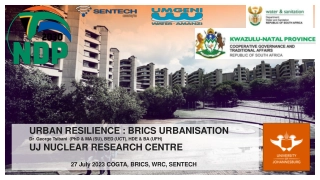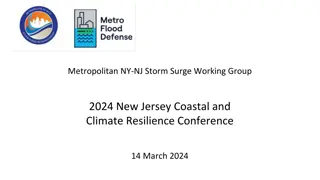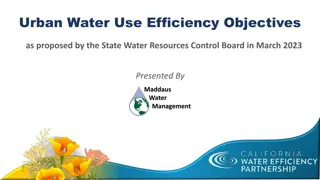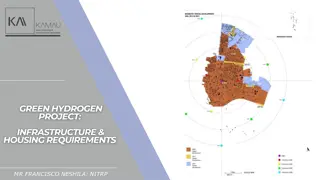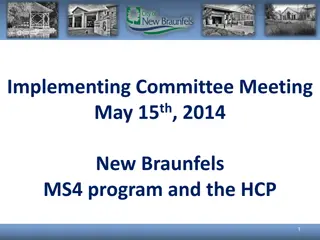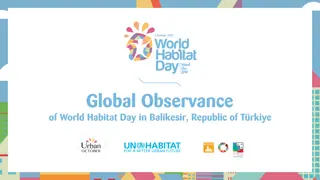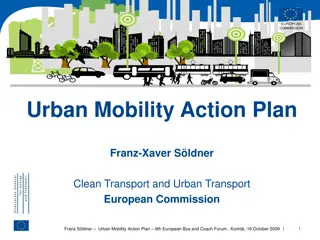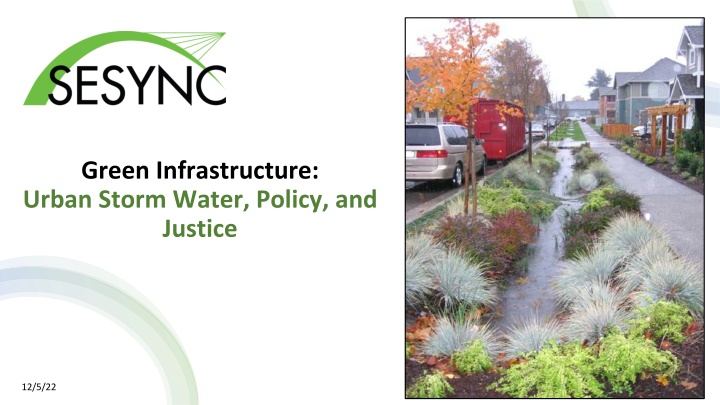
Green Infrastructure: Urban Storm Water, Policy, and Justice
Influence of governance structure on green stormwater infrastructure investment, transitioning from gray to green infrastructure, case studies of Green Leader cities, and environmental justice implications of urban green infrastructure siting criteria.
Uploaded on | 1 Views
Download Presentation

Please find below an Image/Link to download the presentation.
The content on the website is provided AS IS for your information and personal use only. It may not be sold, licensed, or shared on other websites without obtaining consent from the author. If you encounter any issues during the download, it is possible that the publisher has removed the file from their server.
You are allowed to download the files provided on this website for personal or commercial use, subject to the condition that they are used lawfully. All files are the property of their respective owners.
The content on the website is provided AS IS for your information and personal use only. It may not be sold, licensed, or shared on other websites without obtaining consent from the author.
E N D
Presentation Transcript
Green Infrastructure: Urban Storm Water, Policy, and Justice 12/5/22
Hopkins et al. 2018 Influence of governance structure on green stormwater infrastructure investment Combined Sewer Overflow (CSO): When linked, stormwater and wastewater systems in aging gray infrastructure cannot handle the volume of a large rain event; the system releases untreated sewage into local waterways. EPA Policy: Federal Permits require an 85% reduction in CSO events from historic baselines. A 2007 document supports the integration of GI to alleviate CSO problems. Grey to Green: The transition from funding exclusively gray infrastructure projects to integrating small-scale green infrastructure is underway. Hopkins et al. profiled 25 cities policy documents to review their investments in green infrastructure. 1
Hopkins et al. 2018 Green Leader communities: Buffalo, Milwaukee, New York, Syracuse, & Philadelphia devoted at least 20% of their control plan budget to green stormwater infrastructure. Fig. 2. Investments in green and gray infrastructure in each city s most recent control plan. Cities are ranked from left to right in descending order based on the proportion of total control plan cost to be invested in green infrastructure. 2
Hopkins et al. 2018 Study Conclusions: Lip Service vs. Community Services: Discussion of GI in plans did not always correlate with investment in GI (e.g., Omaha, NE). Green Leader Cities: (e.g., Philadelphia, Milwaukee): Prior investment in gray infrastructure freed them to focus on next-phase green projects Policy Push: Federal policy from EPA to regulate CSO runoff and prioritize green infrastructure projects (2007) created a critical policy window for Green Leader cities to invest in GI. 3
Hoover et al. 2021 Environmental justice implications of siting criteria in urban green infrastructure Review of planning documents from 19 cities shows an emphasis of Technological over Social Criteria: Technical siting criteria for GI focus on stormwater and economic implications. These technical criteria have social justice implications, which are unexplored in policy papers. Environmental Justice (EJ) accounted for only 1.2 2% of cited criteria. GI plan development should include EJ community priorities and guard against Green Gentrification. Graph courtesy of NOAA, public domain 4
Hoover et al. 2021 Study Conclusions: Planning documents should prioritize GI in communities that seek this investment and view GI as an integrative solution to social challenges. Trust among stakeholders and empowerment of community members is essential to just policy. Documents should have methods and criteria that match explicitly stated justice goals. Plans should be implemented alongside policy that directly addresses systemic racism, particularly to resist Green Gentrification. Historical marker celebrates activists in Warren County NC in 1982 at the origins of the Environmental Justice movement 5



